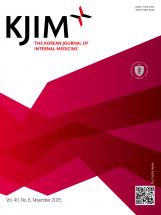|
Cardiology / Original Article
Correlation between NADPH oxidase-mediated oxidative stress and dysfunction of endothelial progenitor cell in hyperlipidemic patients
Ting-Bo Li, Yin-Zhuang Zhang, Wei-Qi Liu, Jie-Jie Zhang, Jun Peng, Xiu-Ju Luo, Qi-Lin Ma
Korean J Intern Med. 2018;33(2):313-322. Published online September 13, 2017
Background/Aims: NADPH (nicotinamide adenine dinucleotide phosphate) oxidase (NOX)-mediated oxidative stress plays a key role in promotion of oxidative injury in the cardiovascular system. The aim of this study is to evaluate the status of NOX in endothelial progenitor cells (EPCs) of hyperlipidemic..
|
|
|
Nephrology / Original Article
The dose of cyclophosphamide for treating paraquat-induced rat lung injury
Jae-Sung Choi, Sung-Shick Jou, Mee-Hye Oh, Young-Hee Kim, Min-Ju Park, Hyo-Wook Gil, Ho-Yeon Song, Sae-Yong Hong
Korean J Intern Med. 2013;28(4):420-427. Published online July 1, 2013
Background/AimsCyclophosphamide (CP) is a promising treatment for severe cases of paraquat (PQ) poisoning. We investigated the effective dose of CP for mitigating PQ-induced lung injury. MethodsAdult male Sprague-Dawley rats were allocated into ..
|
|
|
Original Article
Effect of Glutathione Administration on Serum Levels of Reactive Oxygen Metabolites in Patients with Paraquat Intoxication: A Pilot Study
Jung-Hoon Kim, Hyo-Wook Gil, Jong-Oh Yang, Eun-Young Lee, Sae-Yong Hong
Korean J Intern Med. 2010;25(3):282-287. Published online August 31, 2010
Background/AimsBased on preliminary in vitro data from a previous study, we proposed that 50 mg/kg glutathione (GSH) would be adequate for suppressing reactive oxygen species in patients with acute paraquat (PQ) intoxication. Methods</titl.. </div>
</td>
</tr>
</table>
</td>
</tr> <tr>
<td colspan="3">
<table cellpadding="0" cellspacing="0" border="0" id="article_tbl_162343" style="border:1px solid #ffffff; border-bottom:1px solid #E2E2E2;">
<tr>
<td style="padding-left:10px;padding-right:27px; padding-top:10px;padding-bottom:10px;width:733px;" valign="top" >
<div style="color:#C62F37;font-family:'Noto Sans KR', 'Nanum Gothic', sans-serif;">Original Article </div>
<a class="artiletitle" href="/journal/view.php?number=162343" onmouseover="showAbstract('162343' );" onmouseout="hideAbstract('162343' );"><b><font>Selectively Decreased Expression of Peroxiredoxins Induced by Silica in Pulmonary Epithelial Cells</font></b></a>
<div style="padding-top:2px;padding-left:0px" class="article_authors">Hye Lim Lee, Young Sun Kim, Joo Hun Park, Wou Young Chung, Kyu Sung Lee, Yoon Jung Oh, Seung Soo Sheen, Kwang Joo Park, Sung Chul Hwang</div>
<div style="padding-top:2px;padding-left:0px" class="article_issue">
<em>Korean J Intern Med.</em> 2009;24(3):220-226. Published online August 26, 2009 </div>
<div class="doi">DOI: <a href="https://doi.org/10.3904/kjim.2009.24.3.220"><font class="doi">https://doi.org/10.3904/kjim.2009.24.3.220</font></a>
<a href="/journal/CitedByRenew.php?number=162343" onclick="window.open(this.href, 'CrossRef Citedby', 'width=800,height=800,scrollbars=yes');return false;" style="color:#DD434F;font-size:10pt;"> Crossref 4</a>
</div>
<div class="etc" style="padding-top:5px;text-align: right;">
<a href='/journal/view.php?number=162343' style='text-decoration:underline;color:#2046f8'><img src='/image/button/fulltext.gif' alt='Full Text' /></a> <a href='/journal/view.php?viewtype=pubreader&number=162343' style='text-decoration:underline;color:#2046f8'><img src='/image/button/pubreader.gif' alt='PubReader' /></a> <a style='cursor: pointer;' onclick='journal_download("epub", "162343", "path=L2hvbWUvdmlydHVhbC9rYWltL2pvdXJuYWwvdXBsb2FkL2VwdWIva2ppbS0yNC0yMjAuZXB1Yg==&filename=a2ppbS0yNC0yMjAuZXB1Yg==")'><img src='/image/button/epub.gif' alt='ePub' /></a> <a style='cursor: pointer;' onclick='journal_download("pdf", "162343", "kjim-24-220.pdf")'><img src='/image/button/pdf.gif' alt='PDF' /></a> </div>
<div id="162343" style="display:none;padding-top:10px;padding-left:0px; color:#7b7b7b">
<sec><title>Background/AimsPeroxiredoxin (Prx) belongs to a ubiquitous family of antioxidant enzymes that regulates many cellular processes through intracellular oxidative signal transduction pathways. Silica-induced lung damage involves reactive oxygen species (ROS) that trigger subseque..
|
|
|
Original Article
Effect of High-Dose Intravenous N-acetylcysteine on the Concentration of Plasma Sulfur-Containing Amino Acids
Sae-Yong Hong, Hyo-Wook Gil, Jong-Oh Yang, Eun-Young Lee, Hyung-Kee Kim, Soo-Hyun Kim, Young-Ho Chung, Eun-Mi Lee, Soo-Kyung Hwang
Korean J Intern Med. 2005;20(3):217-223. Published online September 30, 2005
BackgroundThe purpose of this study was to determine the adequate loading and maintenance doses of N-acetylcyseteine (NAC) for patients suffering from acute ROS-induced injury. MethodsConcentrations of extra cellular NAC, cysteine (Cys), cystine..
|
|
|
















